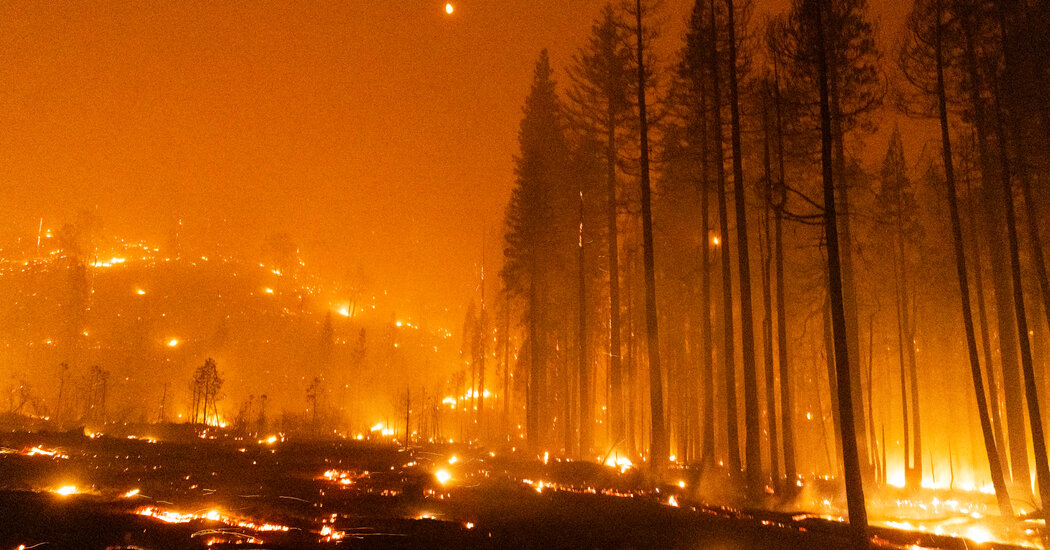The plan is an expensive one, but it is only partially funded.
After a year that included one of the largest wildfires in California history and ended with an unseasonably late blaze that became the most destructive ever seen in Colorado, the Biden administration on Tuesday announced a 10-year, multibillion-dollar plan to reduce the fire risk on up to 50 million acres that border vulnerable communities.
The federal Agriculture Department said in a statement that it would take measures to reduce the danger of catastrophic fires in dozens of spots in 11 Western states by thinning overgrown trees and using controlled burns to get rid of dead vegetation. The plan, detailed in a report, would quadruple the government’s land treatment efforts.
“It’s the time to act,” Tom Vilsack, the agriculture secretary, said at a news briefing on Tuesday, adding that the government needed to “change the trajectory of our wildfires.”
The goal, he said, is to make forests more resilient and “fire-adaptive.”
In the past decade, the number of fires each year in the West has remained fairly consistent. What has changed is their scale.
The 2021 fire season included several extremely large fires. The Bootleg fire, which burned more than 400,000 acres in Oregon, was among the largest in the state’s history. In Northern California, the Dixie fire burned through nearly one million acres to become the second largest in state history.
In addition to California and Oregon, the agency plans to take the preventive measures on land in Arizona, Colorado, Idaho, Montana, Nevada, New Mexico, South Dakota, Utah and Washington.
Drought and extreme heat, made worse by global warming, have played a role by making forests tinder-dry and easier to burn. But many researchers say that more than a century of management policies that called for every fire to be extinguished, no matter how small, also contributed to the problem by allowing dead vegetation to accumulate and add fuel to fires.
That is why the Biden administration has decided to use thinning and intentional burning to restore forests to conditions closer to those that existed in the past, when fire was a regular part of the forest life cycle and naturally removed some trees and dead underbrush.
The plan is an expensive one, but it is only partially funded. A spokeswoman for the Agriculture Department said the department would spend $655 million every year on forest management for the first five years of the plan. That money would be added to $262 million that the U.S. Forest Service had already allocated to the task for this year.
The new money will come from the $1 trillion infrastructure bill that was signed into law in November, the department said.
To carry out the plan on 50 million acres of land would cost around $50 billion, the spokeswoman said. The government spent about $1.9 billion per year on wildfire suppression from 2016 to 2020.
Michael Wara, the director of the climate and energy policy program at Stanford University, said he was worried that the agency had taken on “an enormous challenge” that it did not have the money to complete.
“I do worry the Forest Service is overcommitting itself,” he said on Tuesday.
But if the plan succeeds, fire seasons could be far less catastrophic, Dr. Wara said.
Mr. Vilsack said the Forest Service would work as quickly as possible in vulnerable eras, especially as fire season is now a year-round menace with fires burning into the winter. In December, the Marshall fire swept through communities around Boulder, Colo., becoming one of the most devastating fires in state history.
After the agency, working in tandem with private landowners and Native American tribes, has taken preventive measures in the highest-risk areas, it will move on to other vulnerable zones, he said.
Understand the Lastest News on Climate Change
A warming trend. European scientists announced that 2021 was Earth’s fifth hottest year on record, with the seven hottest years ever recorded being the past seven. A Times analysis of temperatures in the United States showed how 2021 outpaced previous years in breaking all-time heat records.
He added that the Agriculture Department had not paid attention to underserved communities in the past but would make sure they were included this time.
Under the previous administration, former President Donald J. Trump dismissed the link between forest fires and climate change. In the summer of 2020, Mr. Trump blamed California for its fire problem and initially denied the state federal disaster aid.
“You got to clean your floors; you got to clean your forests,” Mr. Trump said at the time, in comments that emphasized just one aspect of a complex problem. He added that “there are many, many years of leaves and broken trees” that are “so flammable.”
Experts say that while Mr. Trump was wrong to dismiss the role played by climate change in exacerbating the fires, he was right that more aggressive forest management is vital for addressing those fires.
Senator Mark Kelly of Arizona, a Democrat, who spoke at the news briefing with Mr. Vilsack, said that it was time to focus more on strategies to prevent wildfires.
“We can’t keep doing the same thing under worse conditions and expect a better result,” he said.
Mr. Vilsack said that while the plan would not stop fires from happening, it would make them less catastrophic. He also pledged that the Forest Service would inform the public of its progress throughout the decade.
After the 10 years of proposed efforts, the Agriculture Department said, it will make a plan to maintain the lands where the preventive measures were taken, which experts say will require regular upkeep.


























